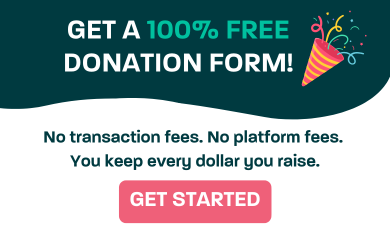What could be better than a grant? It’s essentially free money, often available in large amounts, from a single payer who expects little in return outside of an evaluation report.
Even better, grants are available from a huge number of sources, ranging from tiny family funds to enormous multi-national foundations. There are grants available for individual artists, small non-profits, large universities, and even massive international NGOs.
They are, however, just one leg of a three-legged stool. Let’s take a closer look at each of the legs of the funding stool to get a better sense of how each funding source functions, and when it is the best choice to meet your needs.
Grants
What Are Grants?
Grants are funds provided to non-profits and other selected entities (schools and NGO’s, for example) to underwrite the costs of specific projects or programs. Non-profits write grant proposals describing the project they have in mind and the amount of money they need; proposals are reviewed in a competitive process, and only certain projects or programs receive the money they request. Grants are made to support ONLY the work described in the grant proposal, and they are typically limited to the time period described in the grant proposal.
Why Are Grants Important?
Grants are the tools non-profits use to start something new, pay for important equipment or training, or undertake research. Very, very few non-profits have the “extra” money available to, for example, outfit a laboratory, prepare staff for changing healthcare laws, or hire new staff to create an exciting, innovative, but expensive new exhibit. Grant makers are the organizations that make non-profit growth and innovation possible.
What else do grants offer? Here are just a few of their benefits:
Grants Are Free Money. You don’t pay back a grant, and you don’t provide services in exchange for a grant. You simply do what you said you would do, write a report describing your outcomes, and – you’re done!
Grants Make Large Purchases Possible. How in the world can a small non-profit organization afford to purchase computers, furniture, software, and other equipment needed to start up a vocational training program? Typically, a grant is the best option.
Grants Support Risk-Taking. It’s very tough to make a living as an artist, but it’s even harder when your art is outside of the mainstream. Grants to individual artists make it possible to spend time creating something that may not sell – but may be artistically important.
Grants Enhance Your Credibility. An organization that’s been funded by, say, the National Endowment for the Arts, is more likely to be taken seriously than an organization that is living on credit.
What Do Grants Support?
Grants end. This means that grants are NOT a good choice for funding programs that cannot be supported, in the long run, by fees or by your institutional budget. It is a good idea to write a grant proposal for the following types of expenses:
- One-time expenses associated with launching or expanding a program (purchasing equipment, renovating space, hiring short-term consulting services);
- Short-term projects that can be completed within a predictable period of time (research projects, publications, video production, etc.);
- Seed money for ongoing programs that can be funded through other means in the long term (start up costs associated with opening a museum, starting up a dance company, etc.);
- Professional development opportunities (training staff to handle new laws, new program elements, new software, etc.)
this post.
Sponsorships
What Are Sponsorships?
Sponsorships are cash or in-kind gifts make by corporations (or other non-profits), usually in exchange for marketing/advertising consideration. When you attend your local community theatre or choral concert, take a look at the program: you’ll most likely find a list of “our sponsors,” and you may even see that sponsors have large, full-page ads in the programs. Sponsorships also help to pay for very visible fundraising events such as runs, walks, and marathons, where their logo can be imprinted on runners’ shirts and swag bags. Corporate sponsors are also among the most important funders for exhibits, public radio, and local television.
Why Are Sponsorships Important?
Sponsorships are the visible outcome of local collaborations between non-profits and businesses. When a company decides to sponsor your non-profit, it means that the company believes that an association with you will reflect well on them – and even bring in more business. In addition:
Sponsorships Can Be Ongoing. Once you’ve established a positive relationship with a sponsor, there’s a very good chance you can tap that same sponsor year after year. After all, if the relationship was positive last year, why wouldn’t it be positive this year?
Sponsorships Help Grow Awareness. When the local sporting goods store sponsors your non-profit youth sports organization, they will make the most of their opportunity by posting information about your non-profit and its work in their store.
Sponsorships Build Good Will. When local businesses support your non-profit, the word gets around. Soon, other businesses become interested in your work, as do the individuals who work at and buy from those businesses. Not only can this result in more sponsorships, but it can also lead to increased volunteerism and participation in your non-profit work.
What Do Sponsorships fund?
Because the vast majority of sponsorships are made in exchange for marketing and/or advertising, the key to sponsorship opportunities is visibility. Thus, it makes sense to seek sponsors for public events or programs where corporate logos can be easily seen by the general public. Here are just a few of the types of projects for which sponsorship is a good match:
Performances. Whether your non-profit is a youth orchestra, a local community theatre, or a regional dance group, you can offer sponsors a spot in your program, recognition in your press releases, and mention at the start of each performance.
Exhibitions. Healthcare corporations sponsor exhibits about health. Insurance companies and banks often support art exhibitions. Toy companies support new exhibits at children’s museums. They do so in exchange for seeing their name prominently displayed on the wall and mentioned in press materials.
Sports Programs. Little League, Challenger Leagues, Pop Warner, and many other sports leagues and organizations depend upon corporate sponsors to help pay for uniforms, transportation, field upkeep, and other related costs. The sponsors spend their money because they know they’ll see their logos on caps, shirts, and websites.
Public Fundraising Events. Corporate sponsors are often willing to help underwrite the costs of fundraising runs, walks, auctions, and other happenings. They do so because they know their name will be associated with your good work, and/or their products will be featured at events which their clients are likely to attend.
Donations
What Are Donations?
Donations are philanthropic gifts from individuals, families or corporations. They are not the result of a competitive grant proposal, nor are they payment for advertising opportunities. Donations may come in the form of cash or in-kind gifts such as food from a local grocery store chain, office equipment from a small business, etc.
Donations are typically solicited through annual or quarterly appeals, telethons, fundraising galas and similar events. Many non-profits have created strong donor programs by hosting yearly runs, marches, galas, and so forth. The money you spend on an auction item in support of your local private school or food pantry is a form of donation.
Why Are Donations Important?
A strong donor program is absolutely critical to the ongoing functioning of a successful non-profit. That’s because donations provide a resource as precious and necessary as water: unrestricted funds. Unrestricted funds are available to your non-profit for its day-to-day needs, from operating programs to routine building maintenance.
And there’s more. Not only are donations the single best source of unrestricted funding, they are also:
Predictable. Unlike sponsorships and grants, donations are predictable based on past years. If you ask your members, alumni, or clients for donations every November, after a few years you can make a very good guess about how much you’ll bring in by the end of the year. That’s very important when you’re building a budget.
Likely to Grow. Good fundraisers spend time, money, and effort cultivating their donors. The donor who gave $50 last year could be a $100 donor next year with the right encouragement.
Ongoing. Grants and sponsorships relate to individual programs or projects, and are almost always time limited. When they end, they end, and so does your cash flow. Without a donor program, your non-profit runs a significant chance of simply running out of money.
What Do Donations Fund?
Unrestricted funds are the dollars you use to pay for unglamorous but absolutely essential items such as rent, heat, salaries, benefits, paper, ink, and light bulbs. Unrestricted funds allow your non-profit to pay for a fundraising staff, an office administrator, a human resource professional – people whose work is critical, but is not covered under a project or program grant.
Donations are also the tool many non-profits use to ensure the future of programs that are launched with grant or sponsorship seed money. While few grant makers or sponsors are willing to provide ongoing funds on an annual basis, donors do just that. So you can be sure that the program you launched with a one-year grant won’t die in year two.
The Three-Legged Stool
Even the smallest non-profits should plan on a fundraising strategy that includes grants, donations, and sponsorships. The key, of course, is to choose the right tool for the right need. By thinking creatively, you can build a three-legged funding “stool” that will stand upright and strong for many years to come.




